Author: Zack Pokorny; Compiled by: Vernacular Blockchain
Abstract< /p>
More than 50 days have passed as of 2024. We have seen that the market value of on-chain asset securitization has reached a record high, and the number of addresses participating in DeFi has increased significantly in some major Layer 1 and Layer 2 set the highest record in two years, Ethereum’s Layer 2 ecosystem remains continuously active. This report highlights some of the key trends surrounding the industry through the lens of on-chain data.
Key Points
On February 2, RWA The total market value of tokens reached an all-time high of approximately $2.774 billion, while the tokenized financial asset market (i.e., treasury bills and bonds, private credit, and real estate) also hit a new high on February 8, reaching $1.614 billion. While RWA Token market capitalization has reached this milestone, crypto-native assets are gaining market share in key areas of DeFi.
On the main Layer 1 and Layer 2, the number of addresses interacting with DeFi is close to the highest level in two years, reaching 445,000 addresses. Decentralized trading platforms are one of the most common DeFi applications used when users first use DeFi.
In the Ethereum ecosystem (Layer 1 and main Layer 2), the number of daily active addresses has reached an all-time high, and the number of daily transactions continues to climb. Layer 2 revenue has also grown materially over the past month.
1. RWAs
On February 2, 2024, Tokenization will become a reality The market capitalization of world assets reached a new all-time high of $2.774 billion. It is worth noting that financial assets, including Treasury bills and other bonds, private credit, and real estate, also hit a new all-time high on February 8, 2024, reaching $1.614 billion. Please note that these values only take into account the value of the RWA Token itself on the public blockchain, such as Ondo’s OUSG and Tether’s XAUT, and do not include stablecoins or issuer tokens, such as ONDO and CFG. As of February 26, 2024, the Treasury/bond ratio of financial assets RWA was 58.1%, down approximately 110 basis points from the all-time high.
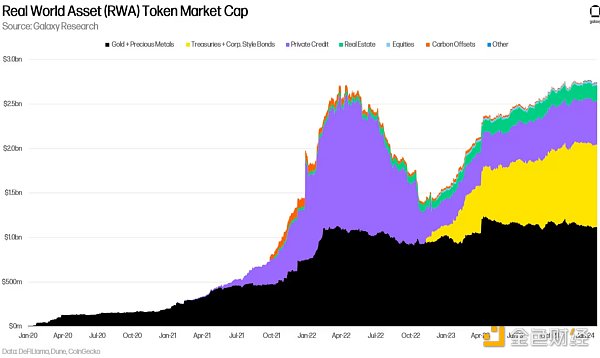
Although the market value of RWA Token has reached a new high on the chain, RWA's dominance and usage among on-chain products is gradually weakening. This is most evident in the staking of DAI,where RWA usage has been steadily declining since the end of October 2023. This is a key sign that highlights the preference for on-chain crypto-native assets over RWA, thereby also increasing demand for cryptocurrencies. The recent growth of LST-backed stablecoins further strengthens this view and suggests that this trend is strong.
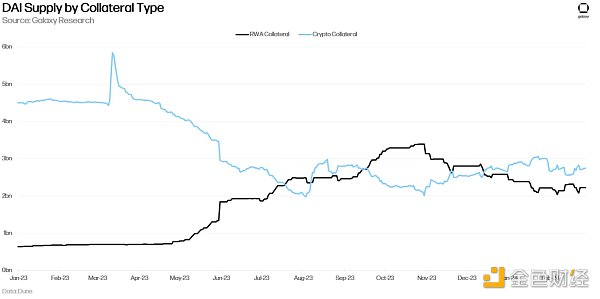
Additionally, the productivity of crypto-native assets has surpassed RWA in some aspects. We mentioned this in our December 1st newsletter, using Maker and DAI as examples, where the stability rate for crypto-collateralized loans is higher than the stability rate for RWA. This dynamic still exists and became even more pronounced after MakerDAO voted to increase the stability rate for certain collateral in its on-chain vault.
Notably, it will increase the rate for minting DAI via one of its stETH vaults by 191 basis points. This is also reflected in the supply APY of major stablecoins relative to Treasury yields. The chart below shows the borrowed quantity weighted average supply APY for USDT, USDC, DAI, and FRAX across Aave v2/v3 and Compound v2/v3. Stablecoin yields have consistently exceeded 3-month Treasury bill yields since late October/early November 2023, just before DAI RWA collateral began to decline.
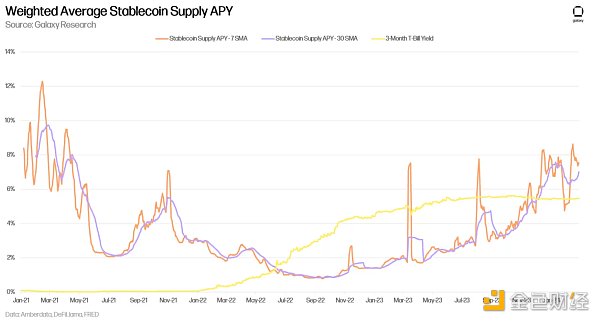
2. DeFi users and retention rate
On the main Layer 1 and Layer 2, use DeFi Daily Active Addresses (DAA) on 7-daySimple Moving Average (SMA) on 2, 2024 On March 1, it reached 576,000 addresses, setting a new two-year high. Solana holds the most daily active DeFi addresses with 196,000 addresses as of February 20, 2024, after previously reaching a high of 330,000 on February 1, 2024 (the day after the Jupiter airdrop) . In contrast, the number of Ethereum DeFi users has continued to decline over the past year (a 24% drop from 120,000 addresses on February 20, 2023). More details on Ethereum’s activity and user numbers will be discussed in the next section.
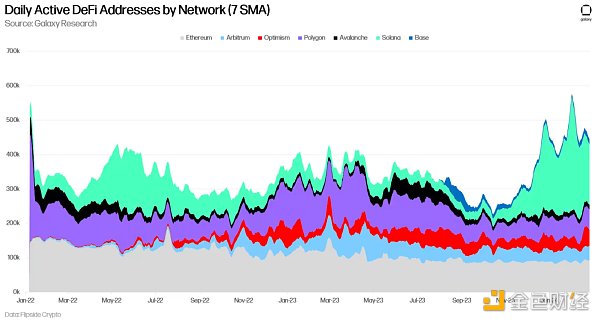
Decentralized trading platforms (Dexes) have become the key for users joining the above seven chains DeFi component. Referring to the chart below, the financial application category includes applications like borrowing platforms and revenue aggregators. Since September 2023, almost 60% of all new users have participated in DeFi on these seven chains, with the majority starting on decentralized exchanges. This is consistent with the wave of airdrops and hype that has occurred around DeFi over the past six-plus months. Additionally, note the growing prominence of NFTs in attracting new users to DeFi over the past three months.
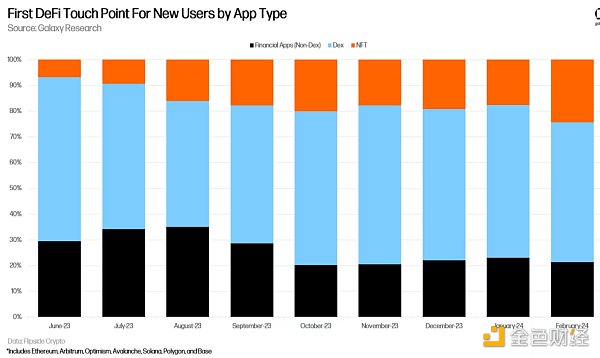
Decentralized exchange (Dex) user retention rates were significantly strong in the three months leading up to January. Solana has the highest Dex user retention rate among the chains observed over the past five months, which can be attributed to Jupiter’s airdrop activity. The chart below tracks the monthly retention rate of Dex users (users who joined in month x and are still trading in month x + 1) on three chains: Solana, Arbitrum, and Optimism. Monthly retention rates for these users began to decline in January 2024 after rising for four consecutive months (six months in Solana's case). Weighted average retention rate is based on new monthly Dex users.
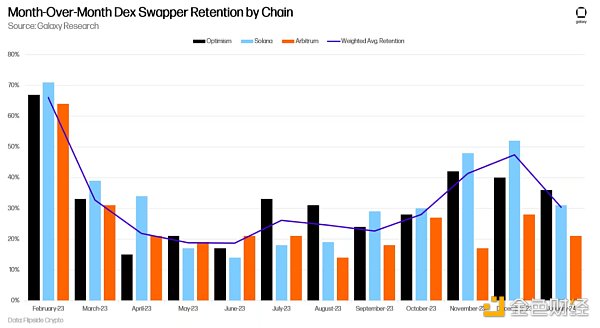
3. Ethereum and Layer2
On cryptocurrency Twitter, Ethereum suffered from a decline in user numbers and overall Criticized for reduced activity. While the number of daily active addresses and activity metrics (such as the number of transactions) have remained flat or declined slightly for much of the past two years, Ethereum is committed to focusing future development on Rollup, so only It's unfair to measure Ethereum through the lens of its L1. Considering some of the top Layer 2 (L2), Ethereum’s user growth and activity are at an all-time high.
The chart below shows the combined network daily active addresses for Ethereum L1 and some major L2s. As of February 21, these networks collectively had more than 1.2 million daily active addresses, with Ethereum L1 occupying only 360,000 addresses. Note that this chart only includes part of Ethereum L2.
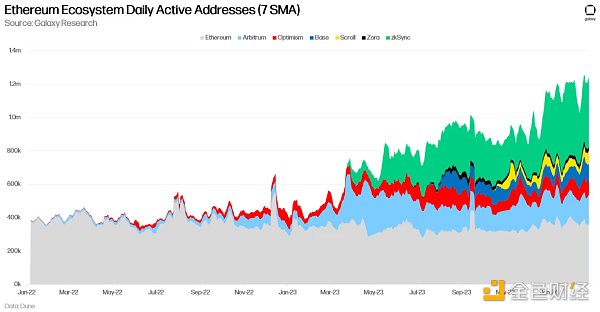
The number of transactions on Ethereum and the same Layer 2 (L2) shows similarly high levels. Although Ethereum L1’s transaction speeds are slower, its L2 ecosystem’s average daily transaction volume reached 3.14 million in the 30 days ending February 26, 2024.
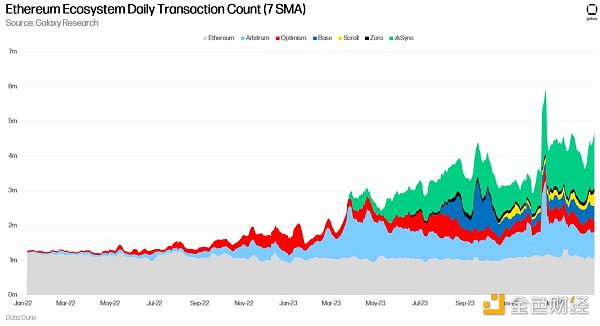
Consistent with the strong deal numbers is growing revenue. As of February 26, 2024, Arbitrum, Optimism, Base, Scroll, Zora, and zkSync were generating $1.5 million in daily revenue using the 7-day simple moving average (SMA) (these are the fees users pay to Rollup sorters). February 26, 2024 also marked the second-highest daily revenue observed for the chain.
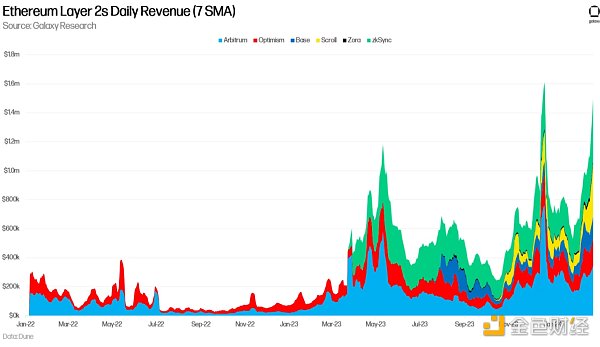
The same L2 paid more than $21.6 million in data costs to Ethereum L1 in the 30 days ending on February 26, 2024. This number will become increasingly important as activities previously performed on Ethereum L1 move to Rollup.
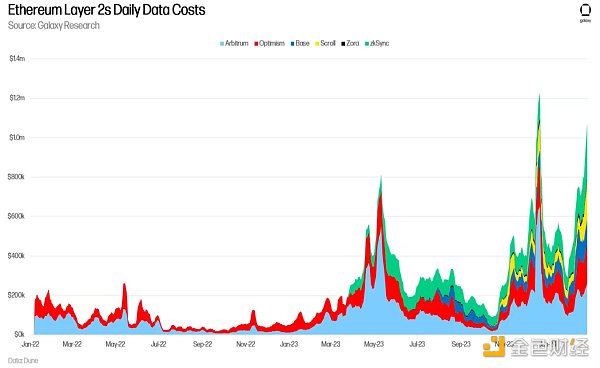
4. Signals and key points
The above data provides some key signals:
1) Signs of continued demand for crypto-native assets to replace RWAs in DeFi remain persistent.
2) Even though the large-scale airdrop has ended, users are still flocking to DeFi. However, the retention rate of decentralized trading platforms dropped in January. This indicates some user exodus or capitulation in this area of DeFi.
3) Although some point out that Ethereum’s activity and number of users have declined, its Layer 2 ecosystem remains vibrant, with transaction numbers near all-time highs.
 JinseFinance
JinseFinance
 JinseFinance
JinseFinance JinseFinance
JinseFinance JinseFinance
JinseFinance JinseFinance
JinseFinance JinseFinance
JinseFinance JinseFinance
JinseFinance JinseFinance
JinseFinance JinseFinance
JinseFinance JinseFinance
JinseFinance 链向资讯
链向资讯